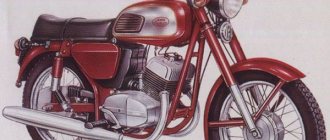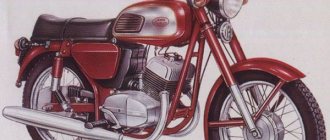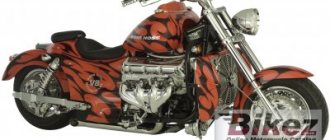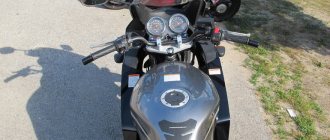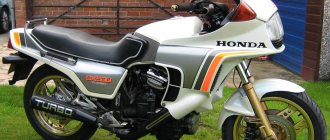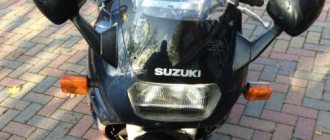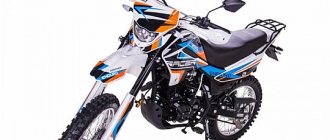There are many legendary motorcycles. The Americans will call you Harley-Davidson, the British - Royal Enfield, the Italians - Moto Guzzy... In the territory of the former post-Soviet space, which includes the countries of Eastern Europe, such a motorcycle is, of course, the Java 350.
Today, when you go to the company’s website, you can find modifications adapted to modern requirements, like the Jawa 350 Replica or Jawa 350 Premier. The legendary brand continues to be popular. But to understand the reasons for this popularity, you should turn to its origins and get to know Java better.
Forward movement
Few people know about this, but the history of a motorcycle with this name began back in 1934. The bike that appeared at that time was equipped with a single-cylinder engine with a power of 12 hp. s., four-speed gearbox, weighed 125 kg. and accelerated to a speed of 100 km/h. He participated in international competitions and won, proving his quality. It was called Jawa 350 SV.
The war made adjustments to the plans of the Czech manufacturer, and the model, which received the Java 350 type 12 index, appeared only in 1948. Due to certain circumstances, it did not last long on the assembly line. The wide Russian consumer had a chance to get acquainted with the next modification - Java 350 354/06, launched into production in 1954. It is this successful car that should be considered the first line in the success story of a popular brand in our country.
Decent characteristics of Java 350
The bike, unlike its predecessors, received a two-stroke two-cylinder engine with a volume of 350 cc. cm, air-cooled. Power increased to 16 hp. s., and in later versions, after installing a new carburetor, up to 18 liters. With.
By the way, the Java 350 carburetor was subsequently modified several times. The maximum speed was 115 km/h (with a direct landing of the motorcyclist). The drum brakes worked reliably, and the front and rear forks with telescopic shock absorbers ensured comfortable movement on paved roads.
This became especially noticeable in 1958, when cone-type shock absorbers were replaced with piston ones. The voltage of the battery and generator used to operate the electrical equipment of the Java 350 motorcycle is 6 volts. Weight – 139 kg. Consumption, for that time, was very moderate - 3.6 liters.
The appearance of the model not only corresponded to the trends of the time, but was progressive and well thought out. It was the modification 354/06 that Viktor Tsoi was seated on by the author of the monument to the famous rock musician, Alexey Blagovestnov. As an element of a monumental composition, old Java looks very harmonious.
There are no boundaries for perfection
In 1964, after modernization, the Java 350 received a new designation - K?va?ka Automatic typ 360/01. The main characteristics, such as power and maximum speed, remained at the same level.
But changing gears has become much more convenient due to the installation of a semi-automatic clutch. The design of the optical elements has been changed. The shape of the wings was adjusted. The popularity of the Java 350 grew and, despite the fairly high cost of the equipment, queues lined up in stores for it.
This model can already be safely called a cult model. Tuning it is not the best solution. Many motorcycle history buffs want to add Java 350 354/06 and 360/01 motorcycles to their collection of rarities.
Design
Not a single biker born at least 30 years ago will confuse this model with any other. The recognizable silhouette with an abundance of chrome and a long, flat seat, a seemingly chopped off taillight and matte aluminum engine covers sunk into the soul of many of us even in childhood or adolescence. The Java 350 differs noticeably from Soviet bikes in being less heavy and more graceful.
Rare and beautiful
One should not think that Czech motorcycles were sold exclusively in Eastern Europe. Jawa products were also supplied to the West. In 1969, an export modification of the Jawa 350 Californian IV typ 362, 363 was developed, which featured an original design. But relatively few such machines were produced.
A little later, in 1970, they released a modification of the Jawa 350 U? typ 633/1 Bizon, the characteristic features of which were a specifically shaped fuel tank and an abundance of compartments for storing tools and luggage. Today such a bike is a rarity, and if you happen to have a similar model at your disposal, then, unlike some Izh Planet-5, its tuning will be simply madness.
Video
The motorcycle we are disassembling today has good driving characteristics.
The hero of this video shows us how to drive a Java-650, both on a city highway and on rough terrain. Did you like the article? Tell your friends!
Comments (1)
- Andrey:
09.22.2016 at 13:06In the video JAWA 634th
Answer
Next step
But time took its toll, and the management of the Czech company decided to make serious changes. In 1973, motorcycle enthusiasts had the opportunity to get acquainted with the Java-350 type 634. On the new bike, the frame design was changed and the engine design was seriously redesigned, increasing power to 23 hp. With.
The maximum speed indicated in the technical description, despite the weight gain of up to 160 kg, increased to 125 km/h. True, fuel consumption has also increased, amounting to 4.5 liters of gasoline per hundred kilometers at a speed of 80 km/h. The advantages of the model are:
- Ease of control and stability at high speeds, which, combined with a comfortable suspension and comfortable seating, had a beneficial effect on the fatigue of the motorcyclist. It was possible to cover a considerable distance behind the wheel without any problems.
- Operational reliability and solid design life.
The main disadvantage was considered to be the high price.
Close relationship
Almost simultaneously with this model, the CZ 350 motorcycle appeared, differing in the design of the frame, the shape of the fuel tank, and suspension settings. If the Java 350 with a sidecar was normal, then the Chezet 350 was sold only in a single version. The model produced at the Cesk Zbrojovka enterprises was considered to be more sporty, although it had characteristics similar to the Java 350.
Technical component
Now about the technical part. This motorcycle had a classic design .
The frame was a tubular carrier, and all the elements were attached to it. The front suspension consisted of a front telescopic hydraulic fork.
At the rear there is a pendulum with two shock absorbers. The braking system is completely drum, with a cable drive at the front and a traction system at the rear.
The power plant is a two-cylinder, two-stroke, in-line arrangement. Cooling is air, and the power system is carburetor. The power plant was started by foot.
The gearbox was foot-switched and had 4 speeds. The drive to the rear wheel was carried out via a chain drive.
The motorcycle was simple in design, but precisely because of this, and even with its spectacular appearance, it was a desirable vehicle for many.
New standards
In 1984, a new modification, type 638, went into production. Changes affected the power unit. The profile and flow area of the intake and exhaust channels were changed, improving the purging of the cylinders. The Java 350 engine received an aluminum cylinder block and lightweight pistons. Power increased to 27 hp. s., and fuel consumption decreased to 4.2 liters. The maximum speed remained unchanged.
An important innovation was the installation of electrical equipment operating at a voltage of 12 volts. The new 12-volt system has significantly reduced the weight of the generator and other electrical components. The measures taken led to a weight reduction to 149 kg. It is based on this model that the Jawa 350 Replica is being produced today.
During production, the design on these Javascripts was adjusted several times. The shape and finish of the fuel tank changed. A small fairing was installed on the steering wheel. No matter what changes the Java 350 underwent, the technical characteristics were at a high level.
Before the crisis
A further development of the model was the Jawa 350 typ 639, launched into production in 1990 and a year later giving way to the Jawa 350 640 modification on the production line. The features of this machine include the front disc brake that appeared in later versions.
There were no major changes in technical parameters. This was the last modification, the production of which was launched before the collapse of the USSR. As for the Java 350 sport, contrary to popular belief, such an option was never produced. Only motorcycles with an engine capacity of 250 cc were awarded the sport prefix. cm.
Motorcycle price
The cost varies from several tens of thousands of rubles to several hundred thousand , although the latter is rare. This kind of money is usually asked for a bike in perfect condition, in which everything is original, down to the last nut. But just in a living state, it’s quite possible to buy a Java 350 thousand for 20-25 rubles , with documents and at full speed.
Java today
At the beginning of the 90s of the 20th century, difficult times came for the Czech manufacturer of motorcycle equipment, as for many enterprises in the post-Soviet space. And yet the company remained afloat. Last but not least, thanks to the large number of Java 350 fans.
The company continues not only to produce motorcycles, but also to supply them to Russia. Some of the models presented in the catalog are direct heirs to the former glory of the brand:
- Jawa 350 Premier is a road bike that can be equipped with an electric starter as an option. The appearance of the car has been changed in accordance with modern ideas about design, but an experienced eye will certainly recognize under the newfangled makeup the Java 350 640 familiar to Russian consumers. Such is the Premier!
- Jawa 350 Lux, like Jawa 350 Premier, is also a reincarnation of the model released in 1991. The modification received an original-shaped fuel tank, a digital instrument panel and a plastic case attached to the trunk.
- Jawa 350 Replica. There is no need to say anything here. The modification was not only created on the units of classic Java 350 motorcycles, but also stylized as models from the heyday of the company.
The popularity of the replicas produced by the company is quite high. The main thing for these models is not speed, but reliability, comfort and recognition. Seeing such equipment in traffic, many sometimes believe that it is tuning.
Tuning examples
Over the many years of its existence, the motorcycle has seen a huge number of tuning variations. All this is due to the low abundance of technology in the Soviet Union, so in order to stand out, you had to use your imagination. One of the most popular options for tuning the appearance was raising the tail of the motorcycle, which was a reference to the Japanese models of that time. Also, the front fender was often clipped. The steering wheel was converted to sports clip-ons.
As for engine tuning, the two-stroke engine has great potential for this. But refining the engine is a much more complicated procedure and requires special skills. The engine power could be increased as follows:
- installation of a resonator;
- installation of two carburetors;
- increasing the compression ratio by reducing the volume of the combustion chamber;
- cutting vent windows;
- liquid cooling installation;
- installation of a reed valve.
Exhaust pipe tuning
Appearance tuning
Appearance tuning
Copy or original?
However, both Jawa 350 Premier and Jawa 350 Replica are unlikely to satisfy a true connoisseur of the legendary brand’s products. Why do they need copies when they can buy the original? After all, in our country you can still find and restore classic Java motorcycles to their original condition. And tuning is inappropriate here!
If you still want to remake some motorcycle equipment to your liking, then on our website you can find out about tuning the Voskhod-3M, a Soviet motorcycle that was mass-produced at the Degtyarev plant in the city of Kovrov.
Previous entry Composition and parameters of electrical equipment IZ Jupiter 5
Next entry Motorcycle Java 350 638: review, technical specifications
Owner reviews
Review #1
Review #2
Review #3
Review #4
Read other motorcycle reviews Moped Alpha: price, photo and video review
